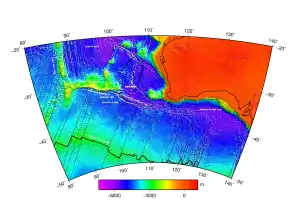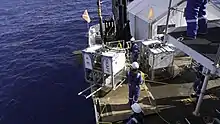Diamantina Fracture Zone
The Diamantina Fracture Zone is an area of the south-eastern Indian Ocean seafloor. It has a range of ridges and trenches.[1] It lies to the south of the mideastern Indian Ocean features of the Wharton Basin and Perth Basin, and to the south west of the Naturaliste Plateau.

Escarpment
Being parallel to the Southeast Indian Ridge, Diamantina Fracture Zone is not a real fracture zone in the sense of plate tectonics,[2] but rather an escarpment, separating two oceanic plateaus. In fact its extension to the west is called Diamantina Escarpment. This is the southern border of the Broken Ridge Plateau. All these features are mirrored by corresponding topography on the other side of the Southeast Indian Ridge. Broken Ridge Plateau was formed at the ridge together with the Kerguelen Plateau.
Exploration
Diamantina Fracture Zone was first detected by RV Vema and RV Argo in 1960. It is named after HMAS Diamantina (K377), which did further exploration in 1961.
Bathymetry

Based on surveys in the year 1960, the Diamantina Deep was considered by the General Bathymetric Chart of the Oceans Gazetteer to be the deepest point of the Indian Ocean with over 8,000 m (26,000 ft) depth at the position 35°S 104°E.[3][4]

To resolve the debate regarding the deepest point of the Indian Ocean, the Diamantina Fracture Zone was surveyed by the Five Deeps Expedition in March 2019 by the Deep Submersible Support Vessel DSSV Pressure Drop, equipped with a Kongsberg SIMRAD EM124 multibeam echosounder system. Using the multibeam echosounder system and direct measurement by an ultra-deep-sea lander a maximum water depth of 7,019 m (23,028 ft) ±17 m (56 ft) at 33°37′52″S 101°21′14″E for the Dordrecht Deep was recorded.[5] Later analysis confirmed that the Dordrecht Deep with an extent of 80 × 95 km and a maximum depth of about 7,100 m (23,300 ft) at 33.42°S 101.48°E was the deepest location in the fracture zone.[3] At the position of the Diamantina Deep, the water depth was only 5,300 m (17,400 ft).[3] This was shallower than previously thought, and confirmed that the Sunda Trench, rather than the Diamantina Fracture Zone, contains the deepest point in the Indian Ocean.[3][6][7] The gathered data will be donated to the GEBCO Seabed 2030 initiative.[8][9] The expedition aimed to thoroughly map and visit the deepest points of all five of the world's oceans by the end of September 2019, at which it was successful.[10]
The shallowest point in the area is the 1125-metre point in the Broken Ridge close to Ninety East Ridge.[11]
See also
References
- Key ecological features of the South-west Marine Region Archived 2011-08-11 at the Wayback Machine
- "IHO-IOC GEBCO Gazetteer of Undersea Feature Names, March 2011 version; www.gebco.net". GEBCO. Archived from the original on 21 April 2012. Retrieved 16 November 2011.
- Heather A. Stewart, Alan J. Jamieson: The five deeps: The location and depth of the deepest place in each of the world's oceans. In: Earth-Science Reviews 197, October 2019, 102896, doi:10.1016/j.earscirev.2019.102896.
- Peter Nunan: HMAS Diamantina. 2nd edition. Boolarong Press, Salisbury 2017. Reviewed by Alan Powell in: The Great Circle, Vol 40, No. 1, 2018, pp. 136–138, published by the Australian Association for Maritime History, JSTOR 26783793.
- "Science Landers Flere, Skaff & Closp". fivedeeps.com. Retrieved 22 October 2019.
- Hydro International.com (18 June 2019). "Exploring the Deepest Points on Planet Earth". hydro-international.com. Retrieved 20 June 2019.
- Five Deeps Expedition (16 April 2019). "Deep sea pioneermakes history again as first human to dive to the deepest point in the Indian Ocean, the Java Trench" (PDF). fivedeeps.com. Retrieved 20 June 2019.
- The Nippon Foundation-GEBCO Seabed 2030 Project
- "Major partnership announced between The Nippon Foundation-GEBCO Seabed 2030 Project and The Five Deeps Expedition". gebco.net. 11 March 2019. Retrieved 19 June 2019.
- "Home". fivedeeps.com. Retrieved 9 January 2019.
- Stow, D. A. V. (2006) Oceans : an illustrated reference Chicago : University of Chicago Press, ISBN 0-226-77664-6 - page 127 for map of Indian Ocean and ridges